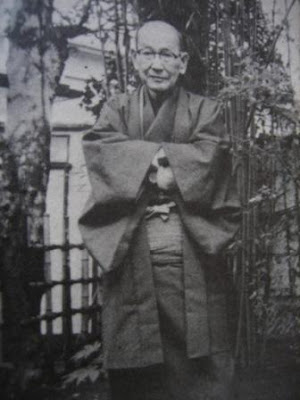[ . BACK to WORLDKIGO TOP . ]
:::::::::::::::::::::::::::::::::::::::::::::::::::::::::::::::::::::::::::::::::::::::::::::::::::
Tomiyasu Fusei (Tomiyasu Fuusei )
富安 風生 (とみやす ふうせい)
His real name was Kenji 謙次.
1885 - 1979
明治18年(1885)4月16日生~昭和54年(1979)2月22日

Famous member of the Hototogisu Haiku Group, from Aichi prefecture. He later founded the "Haiku Association of Tokyo University", Toodai Haiku Kai 東大俳句会 with Mizuhara Shuoshi and Yamaguchi Seishi. They were all students of Takahama Kyoshi.
My own haiku sensei was a student of Fusei sensei.
Fuusei used to teach his haiku students:
People and animals and plants
only show their real face to a person
who looks at them with love and compassion.
人間でも動物でも植物でも、
本当に愛情を持って見つめる人にしか
本当の顔を見せないものだよ
Gabi Greve
:::::::::::::::::::::::::::::::::::::::::::::::::::::::::::::::::::::::::::::::::::::::::::::::::::::

石槌も 南瓜の花も 大いなり
Ishizuchi mo nankin no hana mo ooi nari
The flower of a pumpkin
as well as Mt.Ishizuchi
is great in scale
Fusei Tomiyasu (1885 - 1979) was born in Aichi Prefecture as the fourth son to father "Saburo" and mother "Naka", in 1885. His real name was "Kenji". Naka's father had a Haiku pen name "Baigetsu 梅月 (plum moon)", so his literary talent was descended from his mother.
In May of 1937(Showa 12), he retired as the vice minister of communications after 27 years' service with the Ministry of Communicaions. In Jul. of 1937(Showa 12), he visited Matsuyama for the first time and arrived at Niihama, he composed this Haiku as his first impression of Ehime.
© www.lib.ehime-u.ac.jp
:::::::::::::::::::::::::::::::::::::::::::::::::::::::::::::::::::::::::::::::::::::::::::::::::::::
More English Reference
Japanese Reference
:::::::::::::::::::::::::::::::::::::::::::::::::::::::::::::::::::::::::::::::::::::::::::::::::::::
銀杏散る遠くに風の 音すれば
ichoo chiru tooku ni kaze no oto sureba
scattering gingko leaves
faint sound from the wind
far away
稗蒔や疲れたる眼にみどりなり
hie maki ya tsukaretaru me ni midori nari
millet plants -
pleasant greenery for
my tired eyes
Millet as kigo
吉備の野をここに絞りて山仕事
Kibi no no o koko ni shiborite yama shigoto
the plains of Kibi -
it seems a good place for
work in the mountain forests
Mimasaka area and Haiku
Tr. Gabi Greve
:::::::::::::::::::::::::::::::::::::::::::::::::::::::::::::::::::::::::::::::::::::::::::::::::::::
浪花おどり見つつはあれど旅疲れ
Naniwa odori mitsutsu wa aredo tabi tsukare
I keep watching
the Naniwa dance but
I am tired from the travel
Tr. Gabi Greve / Naniwa Odori
:::::::::::::::::::::::::::::::::::::::::::::::::::::::::::::::::::::::::::::::::::::::::::::::::::::
hatsu fuji ya chazan no ue ni kakure nashi
On New Year's Day
Mt. Fuji presents a brilliant figure
above the tea hills.
Classic Haiku: A Master's Selection
Miura, Yuzuru
Hitohira no koyuki Momiji o tamuke kana
街の雨鶯餅がもう出たか
michi no ame uguisu mochi ga moo deta ka
rain on the road -
are the uguisu mochi
already on sale?
. WASHOKU
Uguisu Mochi - rice cakes in spring
lit. "bush warbler rice cakes", or "nightingale rice cakes".
. . . . .
秋晴や宇治の大橋横たはり
akibare ya Uji no oohashi yokotahari
fine autumn weather -
the big bridge at Uji
spreads over the river
. Uji Festival 宇治祭
:::::::::::::::::::::::::::::::::::::::::::::::::::::::::::::::::::::::::::::::::::::::::::::::::::::
国許の母が来てゐて二の替
Kabuki and Haiku
一位の 実含みて吐きて 旅遠し
Ichii (Yew Tree) and Haiku
この道をふみもまどはず鳴雪忌
kono michi o fumi mo madowazu Meisetsu ki
Naito Meisetsu Memorial Day
まんまろき 月のあがりし 西瓜番
manmaroki tsuki no agarishi nankin ban
:::::::::::::::::::::::::::::::::::::::::::::::::::::::::::::::::::::::::::::::::::::::::::::::::::::
風生先生矍鑠として電波の日
Fuusei sensei kakushuku shite denpa no hi
Master Fusei
is still so vigorous . . .
Radio Day
Kishi Fusanro (Fuusanroo) 岸風三樓 (1910 - 1982)
Radio Day and Haiku
:::::::::::::::::::::::::::::::::::::::::::::::::::::::::::::::::::::::::::::::::::::::::::::::::::
Compiled by Larry Bole:
Blyth is not especially favorable to Fusei. None of Fusei's haiku appears in Blyth's 4-vol. Haiku, and Blyth has this to say about Fusei in Vol. 2 of History of Haiku:
[Fusei] made haiku a kind [of] hobby for people to engage in, in other words his haiku was "popular" in both the good and bad sense. [p. 165]
The popularization of haiku by Fusei was undesirably inevitable... [p. 344]
. . . . .
asagao no hanada no awaki inochi oshi
I love the rest of my life
Though it is transitory
Like a light azure morning glory.
trans. Yozuru Miura
(I think of a haiku by Hakyo as being a companion piece to the above haiku:
asagao-no kon-no kanata-no tsukishi kana
The morning-glory --
far beyond its dark blue,
months and days to come.
Hakyo, trans. Ueda)
Back to Fusei:
hana-kuzu ni kuchi aku koi ya natsu-mekite
To the falling shreds
of blossoms a carp opens its mouth:
summer has come.
trans. Ueda
gasorin no ma-akaki tenba haru no ame
At the gas station
a bright red Pegasus--
spring rain.
trans. Ueda
(I like the above haiku especially because it reminds me of seeing the red Pegasus signs at Mobil gas stations on the long driving vacations my father took our family on in my youth.)
ikkei no yuri no zenryoku ichirai ni
A lily stalk
concentrating all its might
into one flower bud.
trans. Ueda
chichi no goto mata haha no goto oo natsuki
Like a father
and also like a mother,
the huge summer tree.
trans. Ueda
Blyth did translate some of Fusei's haiku, and here is one:
te ni torite hanachishi hagi no eda nagashi
Taking it in the hand,
And letting it go,--
How long the branch of the lespedesa!
trans. Blyth
*****************************
Related words
***** Introducing Japanese Haiku Poets
Mizuhara Shūōshi (Shuuooshi, Shuuoushi)(1892-1981)
Takahama Kyoshi (1874 - 1959)
Yamaguchi Seishi (1901 - 1994)
::::::::::::::::::::::::::::::::::::::::::::::::::::::::::::::::::::::::::::::::::::::::::::::::::
2/22/2010
Tomiyasu Fusei
Subscribe to:
Post Comments (Atom)







2 comments:
顔見世の大番付の端役かな
kaomise no daibanzuke no hayaku kana
on the great showbill
for the Kaomise performance
just a side actor . . .
.
お山開きし甲州街道となりにけり
Kooshuu Kaidoo, Kōshū Kaidō 甲州街道 Koshu Kaido Road
.
Post a Comment